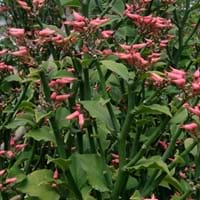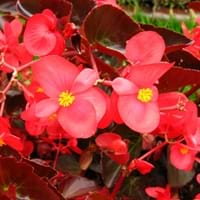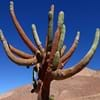Life Span
Perennial
Perennial
Type
Shrub
Tender Perennial
Origin
Madagascar
Hybrid origin
Types
Euphorbia tithymaloides tithymaloides, Euphorbia tithymaloides angustifolia
'Bellagio Apricot' begonia, 'Bellagio Blush' begonia, 'Bellagio Pink' begonia
Habitat
subtropical regions, Tropical regions
Subtropical climates, Tropical regions
USDA Hardiness Zone
9-13
9-15
AHS Heat Zone
Not Available
12-1
Sunset Zone
H2, 13, 23, 24
H1, H2, 14, 15, 16, 17, 18, 19, 20, 21, 22, 23, 24
Habit
Upright/Erect
Upright/Erect
Flower Color
Purple, Orange, Pink, Magenta
Pink, Salmon
Flower Color Modifier
Not Available
Not Available
Fruit Color
Not Available
Tan
Leaf Color in Spring
Green, Gray Green, Burgundy
Red, Green
Leaf Color in Summer
Green, Gray Green
Red, Green, Dark Green, Bronze
Leaf Color in Fall
Green, Gray Green
Red, Dark Green, Bronze
Leaf Color in Winter
Green, Gray Green
Green
Leaf Shape
Ovate
Heart-shaped
Plant Season
Spring, Summer, Fall, Winter
Spring, Summer, Fall, Winter
Sunlight
Full Sun, Partial Sun
Partial Sun, Partial shade
Type of Soil
Loam, Sand
Loam, Sand
The pH of Soil
Neutral, Alkaline
Acidic, Neutral
Soil Drainage
Well drained
Well drained
Bloom Time
Late Spring, Early Summer, Summer, Indeterminate
Indeterminate
Tolerances
Drought
Not Available
Where to Plant?
Container, Ground, Pot
Container, Ground, Pot
How to Plant?
Seedlings, Softwood cuttings
Seedlings, Transplanting
Plant Maintenance
Medium
Medium
Watering Requirements
Average Water Needs, Do Not over Water
Over-watering can cause leaf problems or root diseases, Requires regular watering, Water Deeply
In Summer
Lots of watering
Lots of watering
In Spring
Moderate
Moderate
In Winter
Average Water
Average Water
Soil pH
Neutral, Alkaline
Acidic, Neutral
Soil Type
Loam, Sand
Loam, Sand
Soil Drainage Capacity
Well drained
Well drained
Sun Exposure
Full Sun, Partial Sun
Partial Sun, Partial shade
Pruning
Remove damaged leaves, Remove dead branches, Remove dead leaves
Cut or pinch the stems, No pruning needed in the early stages, Prune if you want to improve plant shape, Prune to control growth, Remove dead or diseased plant parts
Fertilizers
All-Purpose Liquid Fertilizer
All-Purpose Liquid Fertilizer
Pests and Diseases
Red blotch
Aphids, Bacterial leaf spot, Botrytis Blight, Foliar nematode, Powdery mildew, Pythium rot, Rhizoctonia crown rot
Plant Tolerance
Drought
Drought
Flower Petal Number
Single
Single
Foliage Texture
Bold
Medium
Foliage Sheen
Matte
Glossy
Attracts
Hummingbirds
Not Available
Allergy
Carcinogenic, Diarrhea, Skin irritation, Toxic
Asthma
Aesthetic Uses
Cottage Garden, Showy Purposes
Beautification
Beauty Benefits
Skin Problems
Not Available
Environmental Uses
Air purification
Air purification
Medicinal Uses
Asthma, Emetic, Inflammation, Intestinal worms
Bronchitis, Candidiasis, Cold, Digestive disorders, Dysentry, Haemoptysis, Liver problems, Menstrual Disorders, Scrofula, Swelling
Part of Plant Used
Leaves, Root
Whole plant
Other Uses
Tea-like beverage can be brewed, Used as Ornamental plant, Used for its medicinal properties
Used as Ornamental plant
Used As Indoor Plant
No
Yes
Used As Outdoor Plant
Yes
Yes
Garden Design
Container, Houseplant, Mixed Border, Rock Garden, Wall, Tropical
Container, Edging, Houseplant, Mixed Border, Tropical
Botanical Name
Euphorbia tithymaloides
BEGONIA 'Richmondensis'
Common Name
Devil's Backbone
Begonia, Richmond Begonia
In Hindi
Devil's Backbone
बिगोनिया
In German
Devil's Backbone
Begonie
In French
Backbone du Diable
Begonia
In Spanish
El espinazo del diablo
Begonia
In Greek
Devil's Backbone
μπιγκόνια
In Portuguese
Espinha do Diabo
Begônia
In Polish
Kręgosłup diabła
Begonia
In Latin
Narum diaboli
Begonia
Phylum
Magnoliophyta
Magnoliophyta
Class
Magnoliopsida
Magnoliopsida
Order
Malpighiales
Cucurbitales
Family
Crassulaceae
Begoniaceae
Clade
Angiosperms, Eudicots, Rosids
Angiosperms, Eudicots, Rosids
Tribe
Euphorbieae
Not Available
Subfamily
Euphorbioideae
Not Available
Season and Care of Devils Backbone and Begonia
Season and care of Devils Backbone and Begonia is important to know. While considering everything about Devils Backbone and Begonia Care, growing season is an essential factor. Devils Backbone season is Spring, Summer, Fall and Winter and Begonia season is Spring, Summer, Fall and Winter. The type of soil for Devils Backbone is Loam, Sand and for Begonia is Loam, Sand while the PH of soil for Devils Backbone is Neutral, Alkaline and for Begonia is Acidic, Neutral.
Devils Backbone and Begonia Physical Information
Devils Backbone and Begonia physical information is very important for comparison. Devils Backbone height is 90.00 cm and width 30.00 cm whereas Begonia height is 30.50 cm and width 30.50 cm. The color specification of Devils Backbone and Begonia are as follows:
Devils Backbone flower color: Purple, Orange, Pink and Magenta
Devils Backbone leaf color: Green, Gray Green and Burgundy
Begonia flower color: Pink and Salmon
- Begonia leaf color: Red and Green
Care of Devils Backbone and Begonia
Care of Devils Backbone and Begonia include pruning, fertilizers, watering etc. Devils Backbone pruning is done Remove damaged leaves, Remove dead branches and Remove dead leaves and Begonia pruning is done Cut or pinch the stems, No pruning needed in the early stages, Prune if you want to improve plant shape, Prune to control growth and Remove dead or diseased plant parts. In summer Devils Backbone needs Lots of watering and in winter, it needs Average Water. Whereas, in summer Begonia needs Lots of watering and in winter, it needs Average Water.





